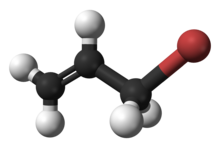
| |

| |
| Names | |
|---|---|
| Preferred IUPAC name 3-Bromoprop-1-ene | |
| Other names
Allyl bromide 3-Bromopropene 3-Bromopropylene 3-Bromo-1-propene Bromoallylene 2-Propenyl bromide | |
| Identifiers | |
| CAS Number | |
| 3D model (JSmol) | |
| ChemSpider | |
| ECHA InfoCard | 100.003.134 |
| EC Number |
|
| PubChem CID | |
| RTECS number |
|
| UNII | |
| UN number | 1099 |
| CompTox Dashboard (EPA) | |
InChI
| |
SMILES
| |
| Properties | |
| Chemical formula | C3H5Br |
| Molar mass | 120.977 g·mol |
| Appearance | Clear to light yellow liquid |
| Odor | Unpleasant, irritating, pungent |
| Density | 1.398 g/cm |
| Melting point | −119 °C (−182 °F; 154 K) |
| Boiling point | 71 °C (160 °F; 344 K) |
| Solubility in water | 0.38 g/100 g H2O |
| log P | 1.79 |
| Vapor pressure | 18.6 kPa |
| Magnetic susceptibility (χ) | −58.6·10 cm·mol |
| Refractive index (nD) | 1.4697 (20 °C, 589.2 nm) |
| Viscosity | 0.471 cP |
| Dipole moment | ≈1.9 D |
| Thermochemistry | |
| Std enthalpy of formation (ΔfH298) |
12.2 kJ·mol (liquid) 45.2 kJ·mol (gas) |
| Enthalpy of vaporization (ΔfHvap) | 32.73 kJ·mol |
| Hazards | |
| GHS labelling: | |
| Pictograms |     
|
| Signal word | Danger |
| Hazard statements | H225, H301, H314, H330, H331, H340, H350, H400 |
| Precautionary statements | P201, P202, P210, P233, P240, P241, P242, P243, P260, P261, P264, P270, P271, P273, P280, P281, P284, P301+P310, P301+P330+P331, P303+P361+P353, P304+P340, P305+P351+P338, P308+P313, P310, P311, P320, P321, P330, P363, P370+P378, P391, P403+P233, P403+P235, P405, P501 |
| NFPA 704 (fire diamond) |
 |
| Flash point | −2 to −1 °C |
| Autoignition temperature |
280 °C (536 °F; 553 K) |
| Explosive limits | 4.3–7.3 % |
| Threshold limit value (TLV) | 0.1 ppm (TWA), 0.2 ppm (STEL) |
| Safety data sheet (SDS) | MSDS at Oxford University |
| Related compounds | |
| Related compounds | Allyl chloride Allyl iodide |
| Except where otherwise noted, data are given for materials in their standard state (at 25 °C , 100 kPa).
| |
Allyl bromide (3-bromopropene) is an organic halide. It is an alkylating agent used in synthesis of polymers, pharmaceuticals, perfumes and other organic compounds. Allyl bromide is a colorless liquid, although commercial samples appear yellow or brown. It is an irritant and a potentially dangerous alkylating agent. Allyl bromide is more reactive but more expensive than allyl chloride, and these considerations guide its use.
Preparation
Hydrohalogenation
Allyl bromide is produced commercially from allyl alcohol and hydrobromic acid:
- CH2=CHCH2OH + HBr → CH2=CHCH2Br + H2O
It can also be prepared by the halogen-exchange reaction between allyl chloride and hydrobromic acid or by the allylic bromination of propene.
Reactions and uses
Allyl bromide is an electrophilic alkylating agent. It reacts with nucleophiles, such as amines, carbanions, alkoxides, etc., to introduce the allyl group:
- CH2=CHCH2Br + Nu → CH2=CHCH2Nu + Br (Nu is a nucleophile)
It is used in the synthesis of compounds containing the allyl functionality, such as the pharmaceuticals methohexital, secobarbital and thiamylal.
Allyl bromide reacts with magnesium metal in dry ether to form allylmagnesium bromide, a Grignard reagent:
- CH2=CHCH2Br + Mg → CH2=CHCH2MgBr
References
- ^ Haynes, William M.; Lide, David R.; Bruno, Thomas J. (2016). CRC handbook of chemistry and physics : a ready-reference book of chemical and physical data (2016-2017, 97th ed.). Boca Raton, Florida. ISBN 978-1-4987-5428-6. OCLC 930681942.
{{cite book}}: CS1 maint: location missing publisher (link) - PubChem. "Hazardous Substances Data Bank (HSDB) : 622". pubchem.ncbi.nlm.nih.gov. Retrieved 2022-03-04.
- ^ Yoffe, David; Frim, Ron; Ukeles, Shmuel D.; Dagani, Michael J.; Barda, Henry J.; Benya, Theodore J.; Sanders, David C. (2013). "Bromine Compounds". Ullmann's Encyclopedia of Industrial Chemistry. pp. 1–31. doi:10.1002/14356007.a04_405.pub2. ISBN 978-3-527-30385-4.
- Bolton, Roger (2001-04-15), "Allyl Bromide", in John Wiley & Sons, Ltd (ed.), Encyclopedia of Reagents for Organic Synthesis, Chichester, UK: John Wiley & Sons, Ltd, pp. ra045, doi:10.1002/047084289x.ra045, ISBN 978-0-471-93623-7, retrieved 2022-03-04
- Mazerolles, Pierre; Boussaguet, Paul; Huc, Vincent (1999). "6-Chloro-1-Hexene and 8-Chloro-1-Octene". Organic Syntheses. 76: 221. doi:10.15227/orgsyn.076.0221.